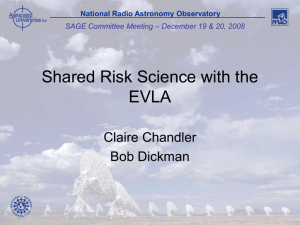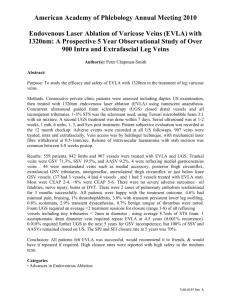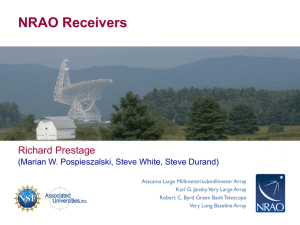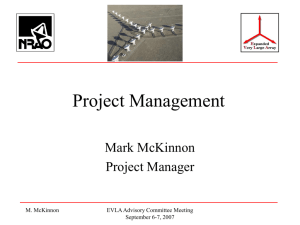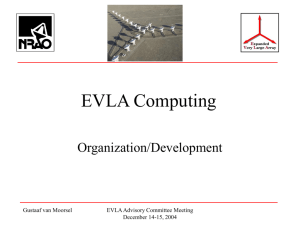EVLA, The Early Science (Chandler)
advertisement
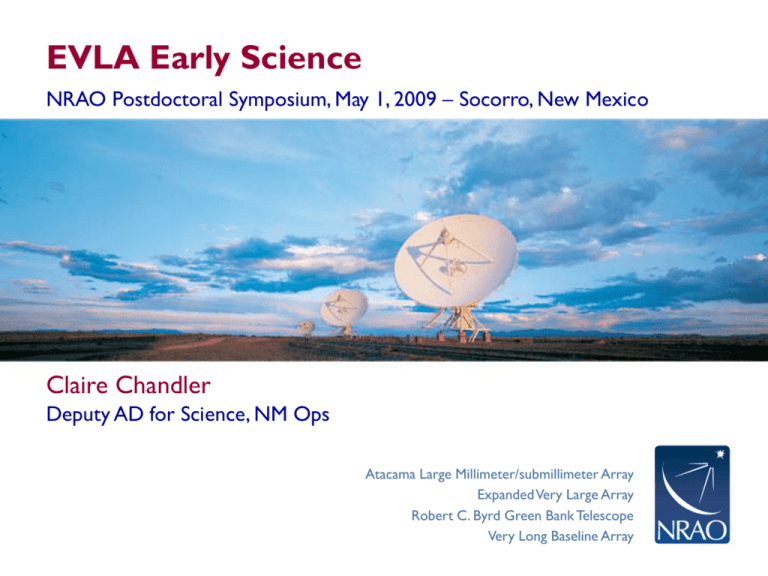
EVLA Early Science NRAO Postdoctoral Symposium, May 1, 2009 – Socorro, New Mexico Claire Chandler Deputy AD for Science, NM Ops Atacama Large Millimeter/submillimeter Array Expanded Very Large Array Robert C. Byrd Green Bank Telescope Very Long Baseline Array EVLA Deliverables • At the end of the construction project (1/1/2013) the EVLA will have: – Hardware complete (1-50 GHz provided by 8 receivers,28 antennas) – Support for essential correlator capabilities, sufficient to serve the vast majority of EVLA users: • 8 GHz BW, full polarization, for continuum applications • 64 separately tunable sub-bands, with adjustable BW and frequency resolution, for spectral line applications – Raw and calibrated visibilities, narrowband reference images for observations taken in standard modes – NRAO-supported data reduction and analysis software • Specialized capabilities (e.g., noise-limited, low-frequency, wideband images, VLBI, pulsar and radar modes) will be added when resources permit 2 Current Capabilities • Currently 21 operating EVLA antennas • Expanded tuning ranges – L-band: 1—2 GHz (interim receiver, limited by old OMTs) – C-band: 4—8 GHz (8 EVLA antennas; rest are interim receivers, polarization purity outside 4.5—5 GHz poor due to old OMTs) – K-band: 18—26.5 GHz (all EVLA antennas) – Ka-band: 26.5—40 GHz (10 EVLA antennas) – Q-band: 40—50 GHz (all EVLA antennas) • New frequencies are available with standard VLA correlator set-ups; IFs separated by up to 10 GHz (Ka/Q-bands) 3 New EVLA/Transition Science • Redshifted H2O megamasers – Impellizzeri et al. 2008, Nature, 456, 927 • z = 2.64 lensed quasar MG J0414+0534, H2O line redshifted to 6.1 GHz • detected by Effelsberg 100m, imaged by EVLA 100m EVLA EVLA 4 New EVLA/Transition Science • 6.7 GHz type II CH3OH masers as tracers of massive star formation – Cyganowski et al., in prep. • show that “extended green objects” in Spitzer/GLIMPSE are associated with massive protostars G19.01-0.03 d~4 kpc G35.03+0.35 d~3 kpc G11.92-0.61 d~4.5 kpc 5 New EVLA/Transition Science • Excited 6.030/6.035 GHz OH masers in stellar envelopes and star forming regions – Fish 2007, ApJ, 669, L81 • Zeeman effect in OH 6.035 GHz masers in the massive star-forming region ON1reveal line-of-sight magnetic field of ~10 mG • Linear polarization will need EVLA C-band receivers now available 6 New EVLA/Transition Science • A new maser in IRC+10216, SiS(J=1–0) at 18.154 GHz – Claussen (in prep.) • Observed previously with single-dish telescopes; imaging in the A-configuration gives TB~33,000 K must be a maser • Provides a new tool for tracing kinematics of circumstellar envelopes at high spatial resolution 7 Ka-Band Science • Ka-band science proposed for special call for exploratory Bconfiguration proposals (began March 2, 2009, ongoing) – 36 GHz methanol masers in the circumnuclear disk – Very hot NH3 in Orion BN/KL • Ka-band science proposed for Feb 1 deadline (CnB/C-configs) – – – – Five proposals for imaging redshifted CO(1–0)/CO( 2–1) in galaxies One proposal to image redshifted HCN(2-1) in a galaxy A search for molecular oxygen at z ~ 0.9 Zeeman effect in a 36 GHz methanol maser Ka-band window covers: CO(1–0) from z = 1.88 to 3.35 CO(2–1) from z = 4.76 to 7.7 HCN(2–1) from z = 1.22 to 2.34 O2 (56.265 GHz) from z = 0.41 to 1.12 8 EVLA Capabilities, 2009-2013 • Antennas: • Receivers: • Samplers: 9 EVLA Capabilities, 2009-2013 • Correlator: – First modes to be offered for general users will be a significant enhancement over VLA correlator, T1 2010 – Then: • • • • Increase bandwidth Increase number of channels Increase flexibility Special modes – Access to these capabilities will be through two Early Science programs that recognize the EVLA is an instrument undergoing commissioning Use of EVLA/WIDAR will be Shared Risk - we’ll do our best to provide good quality data, but no guarantees Full access to current EVLA/WIDAR capabilities by outside users will be quid pro quo 10 Early Science Programs • We have developed two observing programs to provide early EVLA science. They will run concurrently: – The Open Shared Risk Observing (OSRO) program • Access for the whole user community to a number of capabilities beyond those of the VLA • Runs from 2010 until full operations in 2013 – The Resident Shared Risk Observing (RSRO) program • Full access to current EVLA capabilities for peer-reviewed science in return for a period of residence in Socorro to help commission WIDAR, EVLA, and related software systems • Runs for two years, 2010-2011 • Announced in the NRAO eNews, February 2009; see EVLA Information for Astronomers web page, http://www.aoc.nrao.edu/evla/astro/ 11 Open Shared Risk Observing • NRAO has been offering shared risk observing since the EVLA construction project began – – – – New EVLA electronics New on-line computing system New receiver bands New correlator! • “Risk” part of OSRO is at major transitions in capabilities • Initially plan to configure WIDAR in two modes that will provide significant enhancement over the VLA correlator – Further information may be found at http://www.aoc.nrao.edu/evla/astro/osro.shtml 12 OSRO Details • Correlator modes: – For continuum applications and spectro-polarimetry • Two independently-tunable sub-band pairs (IFs), full polarization, each with bandwidth 128/2n MHz (n=0,..,12), 64 channels – For spectral line applications • One tunable sub-band pair (IF), dual polarization, with bandwidth 128/2n MHz (n=0,..,12), 256 channels • Other technical details: – Spectral smoothing, Doppler tracking, tint ≥1 sec – Data rates up to 10x current VLA maximum • Time allocation – Via current time allocation process 13 OSRO Capability Growth • Plan for increase in capabilities for OSRO driven by – science: increase in BW provides biggest science impact – data rates: staged increases of an order of magnitude easiest to manage • Configuration cycle will reverse at the same time that the VLA correlator is turned off • Capability growth: WIDAR Operational; VLA Correlator Turned Off Year 2010 2011 | | Config. D D C B A BW | 256 MHz 2012 | D C B | 2 GHz Construction Completed 2013 2014 | | A D C B A | 8 GHz …(recirc., sp. modes) 14 Resident Shared Risk Observing • Aims to attract expert users to make the most of the early science opportunities with WIDAR, in return for commissioning help • Capabilities available to RSRO users will be all those being commissioned at the time of observation • Notional timescales for RSRO capabilities (depends on science requirements and coordination with EVLA software): – – – – – – 2 GHz total BW, T1 2010 8 GHz total BW, T2 2010 Recirculation, T3 2010 Increased flexibility in correlator resource allocation, T1-T2 2011 Special modes, T3 2011— See http://www.aoc.nrao.edu/evla/astro/rsro.shtml 15 Potential Areas of RSRO Participation • Development of correlator modes – General correlator resource allocation – Multiple spectral lines for Galactic and extragalactic applications – Solar observing – – – – Planetary observing Astrometry Phased array and VLBI Pulsars • Development of observing and calibration strategies – – – – Wideband calibration methods High frequency calibration Improved referenced pointing Ionospheric calibration – – – – Calibrator models Polarimetry Mosaicing RFI excision • Development of data reduction strategies and algorithms – – – – Automated flagging Wideband, wide-field imaging High dynamic range imaging Algorithm development – Algorithm implementation – Post-processing computing and networking optimization – On-the-fly imaging 16 RSRO requirements • At least one expert from each participating group must be in residence in Socorro – must contribute effectively to commissioning – limited support for salaries or accommodation may be available • Proposals will have three parts: 1. Scientific justification, to be peer reviewed as part of NRAO’s current time allocation process 2. Technical section describing personnel and expertise to be involved in the residency, to be reviewed by NRAO staff 3. Budget specifying the level and nature of any support requested from NRAO; proposals that do not require Observatory support will have a substantial advantage over those that request NRAO resources 17 RSRO details • Time available: – Up to 25% of the time available for astronomy will go to RSRO programs (~100 hours/month) • Residency: – Minimum of one month of resident commissioning effort required for every 20 hours of time allocated, minimum residency of 3 months – May take place before the observations, but observers must be present for observations – An EVLA commissioning staff collaborator will not satisfy the residency requirement – Graduate students will not (in general) satisfy the residency requirement – Resident personnel will work under NRAO management with welldefined deliverables 18 Reduction of OSRO/RSRO data • CASA will be the primary data reduction package for the EVLA – One of the goals of the RSRO commissioning is to commission the software – All RSR observers will be expected to use and test CASA at least for initial calibration • AIPS will be available for simple OSRO datasets in the interim – Have already demonstrated a data path from prototype WIDAR to AIPS – Having multiple reduction packages has led to improvements in both CASA and AIPS • We aim to provide pipeline-calibrated uv-data for the standard OSRO modes described earlier by the end of 2010 19 EVLA Science Workshops • A series of EVLA Science Workshops has been initiated, in collaboration with the Science Advisory Group for the EVLA (SAGE): • The EVLA Vision: Galaxies through Cosmic Time – December 2008 • The EVLA Vision: Stars On and Off the Main Sequence – 26-28 May, 2009 20 Upcoming Proposal Deadlines • We will be turning off the VLA correlator at the end of the next D-configuration, January 2010, and moving to the EVLA correlator, as announced in the NRAO eNews, February 2009; see “EVLA Information for Astronomers” web page, at http://www.aoc.nrao.edu/evla/astro/ – Configuration cycle will also reverse at this time, from A→B→C→D to D→C→B→A – June 1, 2009: proposal deadline for the last VLA D-configuration – October 1, 2009: proposal deadline for the first EVLA D-configuration – October 1, 2009: first call for RSRO proposals 21 Backup slides 22 Current VLA Correlator Capabilities 23 OSRO Correlator Modes (1) • Continuum applications and spectro-polarimetry – Two independently-tunable sub-band pairs (IFs), full pol., each with bandwidth 128/2n MHz (n=0,..,12), 64 channels Sub-band BW (MHz) Number of poln. products Number of channels/poln product Channel width (kHz) Channel width (kms-1 at 1 GHz) Total velocity coverage (kms-1 at 1 GHz) 128 4 64 2000 600/n(GHz) 38,400/n(GHz) 64 4 64 1000 300 19,200 32 4 64 500 150 9,600 16 4 64 250 75 4,800 8 4 64 125 37.5 2,400 4 4 64 62.5 19 1,200 2 4 64 31.25 9.4 600 1 4 64 15.625 4.7 300 0.5 4 64 7.813 2.3 150 0.25 4 64 3.906 1.2 75 0.125 4 64 1.953 0.59 37.5 0.0625 4 64 0.977 0.29 18.75 0.03125 4 64 0.488 0.15 9.375 24 OSRO Correlator Modes (2) • Spectral line applications – One tunable sub-band pair (IF), dual polarization, with bandwidth 128/2n MHz (n=0,..,12), 256 channels Sub-band BW (MHz) Number of poln. products Number of channels/poln product Channel width (kHz) Channel width (kms-1 at 1 GHz) Total velocity coverage (kms-1 at 1 GHz) 128 2 256 500 150/n(GHz) 38,400/n(GHz) 64 2 256 250 75 19,200 32 2 256 125 37.5 9,600 16 2 256 62.5 19 4,800 8 2 256 31.25 9.4 2,400 4 2 256 15.625 4.7 1,200 2 2 256 7.813 2.3 600 1 2 256 3.906 1.2 300 0.5 2 256 1.953 0.59 150 0.25 2 256 0.977 0.29 75 0.125 2 256 0.488 0.15 37.5 0.0625 2 256 0.244 0.073 18.75 0.03125 2 256 0.122 0.037 9.375 25
